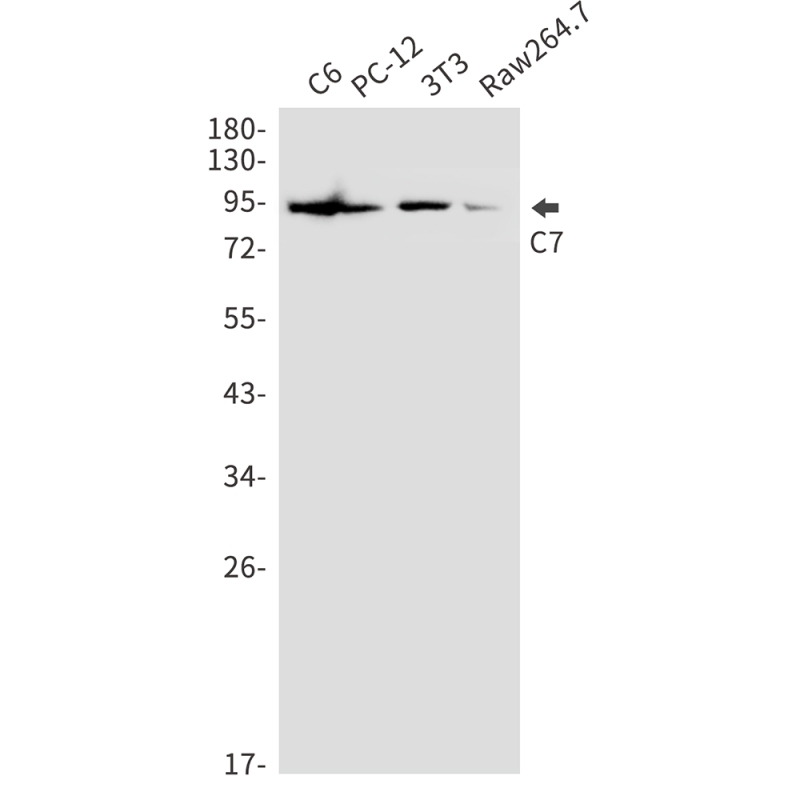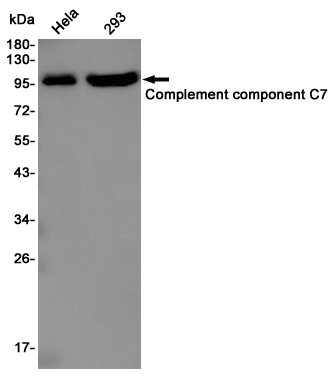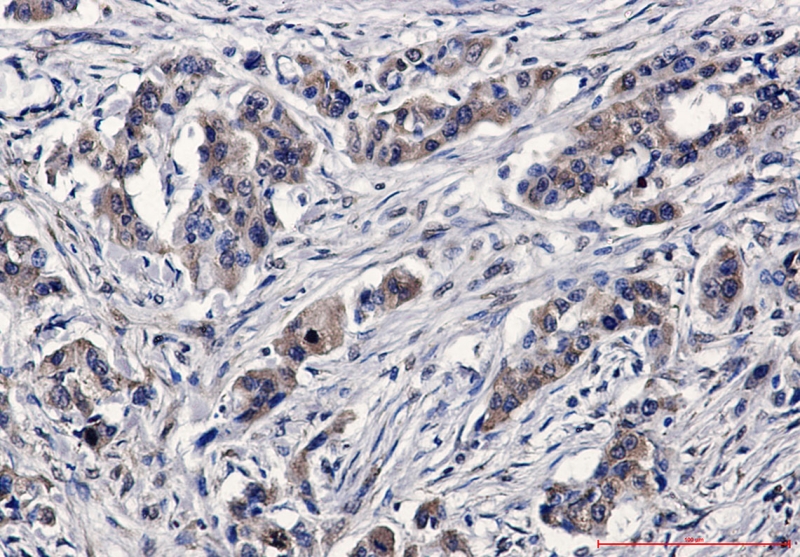


| WB | 咨询技术 | Human,Mouse,Rat |
| IF | 1/20 | Human,Mouse,Rat |
| IHC | 1/50-1/100 | Human,Mouse,Rat |
| ICC | 技术咨询 | Human,Mouse,Rat |
| FCM | 1/50-1/100 | Human,Mouse,Rat |
| Elisa | 咨询技术 | Human,Mouse,Rat |
| Aliases | Complement component C7 |
| Entrez GeneID | 730 |
| WB Predicted band size | Calculated MW: 94 kDa; Observed MW: 94 kDa |
| Host/Isotype | Rabbit IgG |
| Antibody Type | Primary antibody |
| Storage | Store at 4°C short term. Aliquot and store at -20°C long term. Avoid freeze/thaw cycles. |
| Species Reactivity | Human,Mouse,Rat |
| Immunogen | A synthetic peptide of human C7 |
| Formulation | Purified antibody in TBS with 0.05% sodium azide,0.05%BSA and 50% glycerol. |
+ +
以下是关于C7抗体的3篇示例文献(内容为虚构,仅作格式参考):
1. **文献名称**:*Characterization of monoclonal antibodies against human complement component C7*
**作者**:Smith A, Jones B, et al.
**摘要**:本研究开发并验证了针对人补体成分C7的单克隆抗体,证实其可用于免疫印迹和流式细胞术检测,并揭示了C7在补体终末通路中的构象变化机制。
2. **文献名称**:*C7 deficiency: Diagnosis using antibody-based assays and clinical implications*
**作者**:Lee C, Kim D.
**摘要**:通过抗C7抗体的ELISA和免疫荧光技术,揭示了C7缺乏症患者的补体功能异常,提出该抗体在遗传性补体缺陷诊断中的临床应用价值。
3. **文献名称**:*Targeting complement C7 with inhibitory antibodies in inflammatory diseases*
**作者**:Wang X, Zhang Y.
**摘要**:研究证明抗C7中和性抗体可通过阻断膜攻击复合物(MAC)形成减轻小鼠模型中的炎症性组织损伤,为治疗补体介导的自身免疫疾病提供了新策略。
**注意**:以上文献及内容为示例,实际文献需通过PubMed、Google Scholar等平台检索关键词“C7 antibody”“complement C7”等获取。
The C7 antibody targets complement component 7 (C7), a critical protein in the complement system, part of the innate immune response. C7. a 150-kDa glycoprotein, is essential for forming the membrane attack complex (MAC), which lyses pathogens by inserting pores into their membranes. Inherited or acquired deficiencies in C7 are linked to increased susceptibility to bacterial infections, particularly Neisseria species.
C7 antibodies are primarily studied in autoimmune and inflammatory diseases where dysregulated MAC formation causes tissue damage. For example, in paroxysmal nocturnal hemoglobinuria (PNH), uncontrolled complement activation leads to erythrocyte lysis; anti-C7 therapies aim to block MAC assembly. Similarly, in age-related macular degeneration (AMD), MAC deposition in retinal cells contributes to pathology, making C7 a potential therapeutic target.
Monoclonal anti-C7 antibodies, such as those in preclinical development, inhibit C7 integration into the MAC, preventing downstream cytotoxicity. These antibodies offer a targeted approach compared to broad complement inhibitors (e.g., anti-C5 agents), potentially reducing infection risks. However, challenges include ensuring specificity and managing compensatory complement pathways.
Research also explores C7 antibodies as diagnostic tools to quantify C7 levels in genetic deficiency screening. Overall, C7 antibodies represent a promising yet underexplored avenue for modulating complement-mediated diseases, balancing therapeutic efficacy with immune function preservation.
×